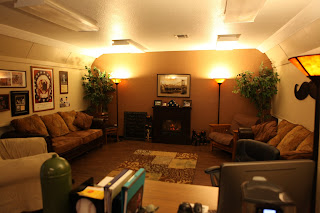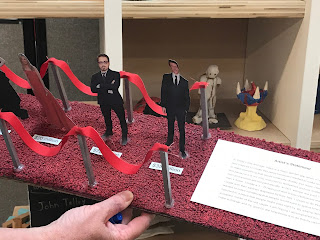The Nueva School was the last visit for Daniel Birch and I on this San Francisco Trip. I feel extremely fortunate to have had the opportunity and am thankful to Daniel for inviting me to join him and Maurie Abraham on this professional development experience. Thanks guys, it has been a pleasure! I've learnt so much and really enjoyed the stimulating conversations, the laughs and the eye-opening experience.
 |
| Maurie (L) & Daniel (R) Passionate educators and foodies! |
For anyone thinking about a visit, San Fran is a very cool place with some really innovative partnerships occurring between the tech industry and schools. I felt like it was a good fit for Hobsonville Point Schools as we continue to push the boundaries and connect with like-minded educators.
Over the past week, we have had some fantastic conversations over extremely good food and the odd margarita. In education we often focus on creating safe and supportive learning environments for children and sometimes I think we lose sight of the importance of doing the same for our staff. If we want to create positive changes in our schools then we have to invest in the teachers and think differently about what quality PD can look like. I know what I've learnt on this trip is going to have a direct impact on the teaching and learning within my school. Being able to collaborate with colleagues is invaluable. It's especially valuable if you can warmly challenge each others thinking and share experiences.
So about Nueva...
Nueva is a private school with a junior, middle and senior campus. Daniel and I visited the junior and middle schools. Maurie visited the senior school. If you are interested you can read Maurie's post here.
A bit of background from their website
Mission and Philosophy
The Nueva School is an internationally-recognized independent PreK-12 school, serving gifted and talented students since 1967. The school is a three-time winner of the US Department of Education National Blue Ribbon Award, winner of the American Institute of Architects Award for School Design and Sustainability, recognized as an Apple Distinguished Program, appointed an Ashoka Changemaker School, a co-founder of the Common Ground Speaker Series, sponsor of the Innovative Learning Conference, and was highlighted by the Pulitzer Prize-winning and New York Times best-selling author Thomas Friedman in his book That Used to Be Us in the chapter “Average Is Over.” Nueva is located in the neighboring towns of Hillsborough and San Mateo, equidistant between San Francisco and Silicon Valley in the Bay Area of Northern California.
Nueva is a student-centered school known for its distinctive inquiry-based interdisciplinary studies, constructivist project-based learning, and its pioneering work in social emotional learning and design thinking. The school also offers specialist teachers in numerous other core and elective areas, including STEM, writing, the arts, entrepreneurship, and physical education.
Vision
The Nueva School uses a dynamic educational model to enable gifted students to learn how to make choices that will benefit the world.
Mission
Our school community inspires passion for lifelong learning, fosters social and emotional acuity, and develops the student’s imaginative mind.
Nueva Junior School is in an old home that once belong to the Crocker Family. The Crocker's were very wealthy bankers and building was one of their summer homes. The building has been transformed into classrooms. It makes for a very interesting space. The spaces were inviting and there was a lovely, child friendly, busy mess around the school.
Nueva Junior School is in an old home that once belong to the Crocker Family. The Crocker's were very wealthy bankers and building was one of their summer homes. The building has been transformed into classrooms. It makes for a very interesting space. The spaces were inviting and there was a lovely, child friendly, busy mess around the school.
Nueva aren't a purist reggio school however there were elements of this in the classes. The outdoor spaces had been transformed using astroturf and the children get out and enjoy the fresh air as much as possible. Some of the classes are connected although most are single cell.
At Grade 3 the classes begin to mix with increasing levels of autonomy and ability to collaborate across age groups.
 |
| Nueva Junior School |
We saw some creative classroom with the use of levels. Lots of the classrooms had raised stages and a few had bunks.
 |
| Loft |
Some of the spaces were multi purpose and changed to suit the learning taking place. This shared space was being used for language workshops when we visited and sometimes it was used for dance classes.
A dispositional curriculum was evident across the school with a big emphasis on feelings, empathy and caring. This fits in with the design thinking approach which runs across the school.
The Stanford d.school physical space influence was at Nueva too. Three big spaces (makerspaces) with lots of technology, engineering and science resources were part of the middle school.
 |
| Multi Purpose Flexible Learning Space in the old ballroom |
 |
| Playground |
 |
| Outdoor Learning Space |
A dispositional curriculum was evident across the school with a big emphasis on feelings, empathy and caring. This fits in with the design thinking approach which runs across the school.
The Stanford d.school physical space influence was at Nueva too. Three big spaces (makerspaces) with lots of technology, engineering and science resources were part of the middle school.
 |
| Design Class |
 |
| Maker Space |
 |
| Maker Space |









































